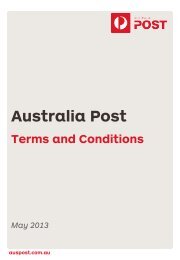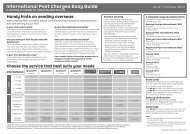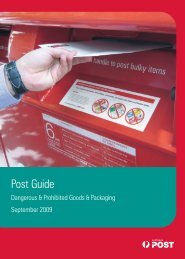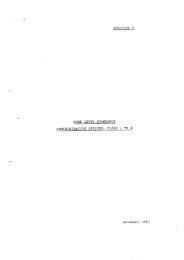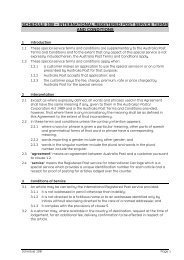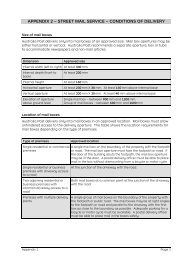2009-10 Annual Report - Australia Post
2009-10 Annual Report - Australia Post
2009-10 Annual Report - Australia Post
You also want an ePaper? Increase the reach of your titles
YUMPU automatically turns print PDFs into web optimized ePapers that Google loves.
notes to And ForminG PArt oF the FinAnCiAl rePort For the year ended 30 June 20<strong>10</strong><br />
29 Financial and capital risk management (continued)<br />
(i) Credit risk management<br />
credit risk refers to the risk that a counterparty will default on its contractual obligations, resulting in financial loss to the corporation or the group.<br />
counterparty exposure is measured as the total value of the exposures to all obligations of any single legal or economic entity (eg a group of<br />
companies). it is the group’s policy that all customers who wish to trade on credit terms are subject to credit verification procedures. the carrying<br />
amount of trade and other receivables reflects the maximum credit exposure when collateral held and other credit enhancements are not considered.<br />
Bank guarantees, parent company guarantees, directors’ personal guarantees, deposits, property mortgages and fixed or floating charges over assets<br />
are held in respect of receivable balances from some customers. in addition, receivable balances are monitored on an ongoing basis with the result<br />
that the exposure to bad debts is not significant.<br />
the credit risk on liquid funds and derivative financial instruments is limited because the counterparties are high investment grade as rated by<br />
standard & poor’s, bank counterparties are all rated a- or better (<strong>2009</strong>: a- or better) by standard and poor’s and counterparty limits have been<br />
established and are endorsed annually by the board and reviewed regularly by the treasury Group.<br />
the credit risk on derivative financial instruments is managed using the principle of the apra “current exposure Method” as described in its guidance<br />
note aGn 112.2, which takes into account both the current credit exposure and the potential future credit exposure from derivative financial<br />
instruments.<br />
the corporation and the group have a significant credit risk exposure from the long term loan advanced to star track express, a jointly controlled<br />
entity, of $128.2 million (<strong>2009</strong>: $128.2 million). there are no other significant credit risk exposures to any single counterparty or any group of<br />
counterparties having similar characteristics.<br />
except as detailed in the following table, the carrying amount of financial assets recorded in the financial statements as summarised in note 29 (c),<br />
net of any allowances for losses, represents the corporation’s and the group’s maximum exposure to credit risk without taking account of any<br />
collateral held or other credit enhancements.<br />
maximum credit risk from financial assets and other credit exposures<br />
drawn loans to controlled and jointly controlled entities (1)<br />
undrawn loan commitments to controlled and jointly controlled entities<br />
Guarantees provided (2)<br />
92<br />
AustrAliA <strong>Post</strong> AnnuAl rePort <strong>2009</strong>–<strong>10</strong> | Financial and statutory reports<br />
20<strong>10</strong><br />
$m<br />
consolidated corporation<br />
(1) the carrying amount of loans to controlled entities and jointly controlled entities differs from the maximum exposure to credit risk, as a loan advanced to a jointly controlled entity<br />
is non-interest bearing and the loan carrying amount has been discounted under the effective interest method.<br />
(2) relate to bank guarantees over projected workers’ compensation claims liabilities, financial guarantee contracts and other guarantees provided by jointly controlled entities.<br />
(j) liquidity risk management<br />
liquidity risk refers to the risk of encountering difficulties in meeting obligations associated with financial liabilities. liquidity risk management is<br />
associated with ensuring that there are sufficient funds available to meet financial commitments in a timely manner and planning for unforeseen<br />
events which may curtail cashflows and cause pressure on liquidity. the corporation and the group measure and manage liquidity risk by forecasting<br />
liquidity and funding requirements for the next three years as a minimum, which is reviewed annually by the board as part of the treasury strategy<br />
paper. in addition, the corporation prepares and reviews on a daily basis a rolling daily cash forecast for the quarter.<br />
liquidity risk tables<br />
the following tables detail the corporation’s and the group’s remaining contractual maturity for its non-derivative financial liabilities. the tables are<br />
based on the undiscounted cashflows based on the earliest date on which the corporation or the group can be required to pay. the tables include<br />
both interest and principal cashflows. Where interest flows are floating rate, the undiscounted amount is derived from the interest rate curves at the<br />
end of the reporting period. For financial guarantee contracts and undrawn loan commitments, the maximum amount of the guarantee and undrawn<br />
loan commitment is allocated to the earliest period in which the guarantee or loan commitment can be called.<br />
the tables also include cash outflows arising from derivative financial instruments. the tables are based on the undiscounted net cash outflows<br />
on derivative instruments that settle on a net basis and the undiscounted gross cash outflows on those derivatives that require gross settlement.<br />
the amount disclosed has been determined by reference to the projected cash outflows illustrated by the yield or forward curves existing at<br />
reporting date.<br />
130.5<br />
4.3<br />
247.0<br />
<strong>2009</strong><br />
$m<br />
131.8<br />
4.3<br />
256.4<br />
20<strong>10</strong><br />
$m<br />
130.6<br />
16.2<br />
2<strong>10</strong>.4<br />
<strong>2009</strong><br />
$m<br />
132.0<br />
29.4<br />
217.4




